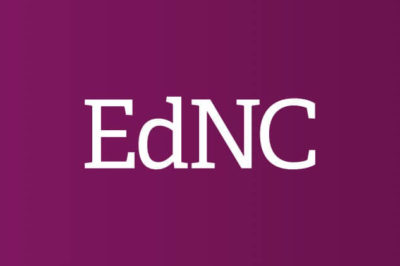

For Justin Perry, all of this—the landmark court case that dismantled Charlotte-Mecklenburg Schools’ (CMS) diversity-friendly school assignments at the turn of the century, the bitter wringing of hands that followed and, today, a school system seemingly more stratified than any other in North Carolina—began for him 17 years ago, in front of Charlotte’s austere district courthouse on a spring day.
Perry, a senior at West Charlotte High, a formerly all-black school on the city’s west side, was protesting a court case that found one white parent suing the school system over the claim that his daughter was twice denied entry to a local magnet school on the basis of her race.
“Even as high schoolers, we had a feeling it would ultimately lead to what we’re seeing now, which is resegregated schools,” says Perry.
Statistically speaking, Perry’s right. Nearly 20 years later, a staggering 93 of CMS’ 168 schools served student populations where a majority were considered “economically disadvantaged,” a group disproportionately made up of minority students that qualified for the free and reduced lunch program.
In 65 schools, the problem was even worse. More than 70 percent of students in these schools qualified as “economically disadvantaged,” despite the ever-piling reports of the deleterious effects on education of such high concentrations of impoverished children.
Today, in CMS, it’s harder to put numbers to the problem. The system participates in a federally-backed program that provides free lunch to all students in 79 of its most low-income schools, meaning it no longer tracks system-wide data on free and reduced lunch, a spokesman said last week.
But for Perry, the problem endures, and the political is personal. Now a 35-year-old therapist in Charlotte’s Plaza Midwood neighborhood, Perry says his two-year-old son, when he comes of age, will be zoned to attend Walter G. Byers School, a chronically struggling K-8 school where more than 90 percent of its students hail from low-income families.
It was a major concern for Perry, raised in the 1990s in CMS’ nationally-recognized “open” schools program, a predecessor to magnet schools that allowed students of various socioeconomic groups and races to mingle. Perry says the experience made him more civically engaged.
“To think about it now, I think it’s pretty significant,” says Perry. “To even have that ability for critical thinking and insight, it was not just about teaching to a test and learning how to build a college resume. You were learning about how your education applied to your everyday life. I think that’s why you see so many folks who went down that path who are civic-minded.”
Still, Perry may have been worried about CMS’ startling data, but he didn’t take any action until roughly a year ago, when he responded to a Facebook post seeking others who were fired up over Charlotte’s bitter school divide. When he arrived at that meeting, he expected a handful of agitated parents, but more than two dozen showed.
“It was great looking around the room, seeing folks of different races, different ages,” Perry says. “I thought, ‘Wow, we might actually have a chance of having an impact on the discussion.’”
Weeks later, Perry helped co-found a campaign that now calls itself One Meck, aimed at pressuring local leaders into addressing the racial divisions in the school system.
Named “one of seven to watch” by the Charlotte Observer this year, Perry’s group counts a handful of victories already—pressuring school board members into factoring diversity in a pending reassignment and prompting the board to hire an outside consultant for just that purpose.
But there’s not much cheer in Perry’s voice today. There’s much work to do in Charlotte and across the country, he notes, particularly in places like Wake County, the only school system larger than CMS in the state.
It’s a tale of two cities to Perry, both listing toward a divided roster of schools where not all will receive the same education.
Once seemingly immune to racially isolated school assignments, thanks to a nationally recognized school assignment diversity plan, Wake County Schools has changed drastically since a Tea Party takeover of the county school board in 2009 led to a razing of its longtime assignment plan.
Since then, despite a shift to a Democratic majority on the school board, the number of Wake County schools serving a majority of low-income children on the free and reduced lunch program has more than doubled, surging from 18 in 2008 to 48 this school year.
In 2008, Wake County reported no schools with low-income populations exceeding 70 percent. Today, 20 such schools can be found in Wake County.
“We’re at a critical point in Wake County right now,” Wake County Commissioner Jessica Holmes, an education law attorney elected in 2014, told N.C. Policy Watch this week. “And we have to get the message out that diversity is not just the right thing to do, it’s the best thing to do for our children. It’s not just diversity for diversity’s sake.”
In Wake County, school activists have launched their own initiative, dubbed the Great Schools in Wake Coalition, that cites school diversity among its greatest concerns. Yevonne Brannon, chairwoman of the coalition, says it’s “time for more than lip service” in Wake County.
Perry understands the frustration. After all, he was talking about this in 1999. He’s talking about it today. In another 15 years, he hopes it’s a relic of the past.
“To me, it’s a moral issue,” says Perry. “It’s a social justice issue and it’s an economic issue. For us to take the path of cities like Baltimore and Detroit that allowed their cities to become more segregated, we’re not doing a good job of learning lessons.”
***
To Richard Kahlenberg, a senior education researcher at the progressive Century Foundation, the debate over diversity in schools is all but over. He chuckles when it’s compared to the similarly sealed—at least in most scientists’ minds—debate over global warming.
“I think it’s safe to say that there’s a social science consensus that high-poverty concentrations are bad for education,” said Kahlenberg. “Unfortunately, there’s an outdated political consensus that there’s nothing you can do about it.”
Education scholars like Kahlenberg, one of the nation’s leading advocates for economic integration, note droves of research papers that cite the positive impacts of diversity in K-12 schooling, including enhanced critical thinking, higher academic achievement, greater civic responsibility, higher college-going rates and more lucrative jobs.
None of this is surprising to Perry. “I’m able to look at things not just on a micro level, but on a macro level,” says Perry. “I think it’s directly attributable to my experience.”
Indeed, Kahlenberg says five decades of research shows that low-income children attending middle- and upper-class schools tend to excel, while their low-income peers trapped in traditionally “poor” schools can lag as far as two academic years behind.
And the proposal is not just a boon for the needy. Kahlenberg notes middle- and upper-class students, also benefit, leading to more globally-conscious citizens that are more attractive to employers.
Despite the research, Kahlenberg says the trend in North Carolina’s largest school systems today is “very troublesome,” one exacerbated by mounting evidence that the state’s proliferation of new charters is only compounding the problem.
A report last April by researchers at Duke University found many individual charter schools in North Carolina were either predominantly white or predominantly minority. Such is the case in Wake County, where county Board of Education Chairman Tom Benton says charters are hopelessly split along racial lines.
“What it is allowing us to do is it is allowing us to resegregate our schools,” says Benton. “Even thinking that the numbers would be tilted, it was just much more tilted than I thought. It’s the type of thing that most people who look at it say, ‘Oh my god. I had no idea it was this bad.’”
Last year’s Duke report found that more than two-thirds of charter students in North Carolina attend schools considered “highly segregated,” meaning their enrollment is more than 80 percent white or less than 20 percent white. About 30 percent of students in traditional public schools would fall into that category.
And while the overall numbers are somewhat muddled in the data, state officials still reported increasingly white charter schools this year, so much so that the state’s Lt. Gov. Dan Forest, a GOP champion of school choice, asked to pull a demographics report from the State Board of Education’s agenda in January because it was too negative.
That report showed charters were bucking trends in traditional schools which, overall, are admitting more and more minorities. Yet more than 57 percent of charter students are white this year, the state said.
It’s a seriously complicating factor for local school boards, says Benton. “We have to be honest. Parents now have choices. In the old days, we could assign students to schools and parents could take it or leave it. Most of the time they had to take it.”
Parents of privilege, he points out, have a chance to take their children elsewhere, and often do. In this trend, North Carolina is unique, Kahlenberg says, because many charter schools across the nation are located in economically distressed neighborhoods brimming with impoverished, minority children. In North Carolina, charters can be a destination for “white flight.”
“Charters want to reach kids of the greatest needs, but one of the best things you can do for low-income kids is give them the chance to go to middle-class schools,” he said.
Of course, school choice is not the only cause for urban school districts’ ills, advocates say. Wake County’s longtime diversity assignment plan helped to blunt the problem in the county, but the assignment plans put in place beginning in 2009 have only segmented the school population, experts say.
And while a majority of Wake County leaders today are pro-diversity advocates, they have yet to speed major reforms to stem the tide. That may be about to change.
Since last year, Wake County commissioners and school board members have been meeting with school advocates to plot their response to the school system’s problem.
Benton says Wake County’s issue defies easy answers. Moving poor children, who are increasingly settling in “the rim” between Interstate 440 and Interstate 540, into high-wealth districts may not be an option. Sometimes the bus ride would take more than an hour, he says.
“In the good old days, there was a line of support and acceptance that diverse schools were good for the larger community,” said Benton. “That has been eroded and we have increasing numbers of parents on all sides that support the concept of neighborhood schools. It’s eroded support from virtually all aspects of the political spectrum.”
Benton said the board will likely consider “reasonable busing patterns” or magnet programs to assuage the segregated schools.
“To use busing as your only tool to do that can’t happen,” he said. “As we look at all those factors, we are trying to figure out different ways. I wish I could tell you answers. We don’t have them.”
Indeed, pro-diversity advocates like Justin Perry, One Meck and Great Schools in Wake are shifting their message these days.
“We have no intention of returning to busing as we used to do it,” Perry told Policy Watch this week. “That’s something that’s been used to mobilize folks against diversity.”
Instead, he says, leaders in Charlotte should address “racially gerrymandered” school boundaries in the system. One Meck has also pushed local leaders to weigh diversity and proximity equally during the school assignment process.
Mary McCray, chairwoman of the Charlotte-Mecklenburg Schools Board of Education, says reform will take time and money. With most county residents openly opposed to large-scale busing plans today, the city will likely move instead to expand the presence of local magnet schools, which can accept students from all over the county, and plan building such schools along established transit options.
That way, the schools will be more attractive to low-income families, she says.
Charlotte school leaders are also ramping up pressure for a school bond package in the coming years. The system’s last bond, approved in 2013, included $290 million for high-priority, infrastructure needs, although the school system estimated its total capital needs at around $1.8 billion in the next decade.
McCray said some of the system’s most overburdened schools are being stressed by growth, which contributes to the problem in Charlotte’s more troubled schools.
“If we had a bond package similar to Wake, we could see our way coming out of it,” says McCray. “But 10 years ago, we were here and we had this problem. It still hasn’t gotten any better. It’s just a difficult story for us.”
It’s not all the local school board’s fault, says Justin Perry of One Meck. Housing patterns and lack of affordable housing options, just as in Wake County, have made it a challenge to offer diverse schools to increasingly segmented neighborhoods.
Leaders in both Wake and Mecklenburg say their counties must boost affordable housing options. “We have to have diverse communities before we can have diverse schools,” says Wake Commissioner Jessica Holmes.
To that end, Wake leaders, including Holmes, have begun pushing increased funding for active housing nonprofits like Habitat for Humanity and Passage Home.
Holmes said leaders may also consider more innovative options too, like constructing future affordable housing sites on surplus school properties to increase access to new schools for low-income children.
These reforms take time, most point out. In lieu of any short-term fixes, school leaders say the focus must be on things they can control: such as providing adequate resources for schools, if not at the state level, at the local level.
“I don’t just automatically jump to the conclusion that the only way to make sure they have a quality education is that poor kids sit next to affluent kids,” said Benton. “Affluent schools tend to have a higher number of high-quality, experienced teachers. They have better supplies, and more exposure to the belief system that they would go to college.”
To fill the void, officials say high-priority schools need additional counselors, incentives for teachers and enhanced enrichment activities for children.
Meanwhile, Kahlenberg says he’s hoping for more “aggressive” action from Democratic leaders in places like Wake County, where some progressive leaders have been criticized for failing to turn around increasing segregation in the school system.
But Benton, chair of the Wake County school board, says his board has the difficult job of reversing the trend without implementing policies so unpopular that they push parents of high-performing children, regardless of race or socioeconomic status, out of Wake County, a possibility Benton calls “bright flight.”
“In an ideal world, we’d just be able to bus kids and make it all better,” says Benton. “But we’re not living in an ideal world anymore. I don’t think I’m a leader who lacks courage, but I am a leader who has to look at what a lot of people consider reasonable.”
Without major reforms, Yevonne Brannon, of the Great Schools in Wake Coalition, says Wake is bound for the same problems as Mecklenburg County.
“Mecklenburg County, they did everything wrong ahead of us,” she says. “Now they’re trying to swim backwards, but the backstroke is harder than the free-style. Here in Wake County, we’re just trying to tread water.”
***
“When your kids can’t multiply regular numbers, they’re going to have a hard time multiplying fractions. Carrie Tulbert, principal of Concord Middle School in Cabarrus County and North Carolina’s principal of the year in 2014-2015, has intimate experience serving a school dominated by the children of poor families.
Her suburban school, which reported about 74 percent of its students on free and reduced lunch last year, earned a school performance grade of “F” in 2014-2015 and experienced soaring teacher turnover of more than 26 percent.
At a panel convened last week by the Public School Forum of N.C., a research and advocacy group in Raleigh, Tulbert was one of several principals at low-performing schools—many of them teeming with low-income children—who described how their children tend to arrive lagging behind their middle-class and upper-class peers.
Tulbert said it’s a daily struggle to retain and recruit teachers in such schools, and that legislators must understand the turnaround process for such schools can take up to five years.
Rusty Hall, principal of Old Town Elementary in Winston-Salem, says all of the students at his “low-performing school” qualify for free and reduced lunch. And despite a determined set of teachers and administrators, Hall said his school has also struggled to overcome the long odds.
“The negativity that comes with that low-performing designation pushes back on us,” said Hall.
Reform for North Carolina’s chronically struggling schools figures to be the zeitgeist in public education this year. Last week’s panel came as Republican lawmakers pushed legislation that could wrest control of some chronically low-performing schools from local school boards, placing staffing and curriculum powers in the hands of for-profit charter operators in so-called “achievement school districts.”
The public schools have failed these low-income students, supporters say, but critics of this approach say it neglects the sociocultural barriers for schools serving a predominantly impoverished population. Addressing the far-reaching impacts of poverty and increasing diversity in such schools should play a greater role in improving these schools, advocates say.
“It’s very hard to explain all of this in sound bites,” says Brannon. “Socioeconomic and racial diversity is the key to student success. This is what research shows us over and over.”
Justin Perry is a believer.
Perry says he can count numerous classmates from his “open” school days who are civic leaders and successful adults today. Today though, Perry worries thousands of the city’s children, including his son, won’t have the same opportunity.
“I want my kids to realize they’re part of a greater community,” says Perry. “And they have a responsibility to their community.”
Editor’s Note: NC Policy Watch published this post on March 23, 2016.



